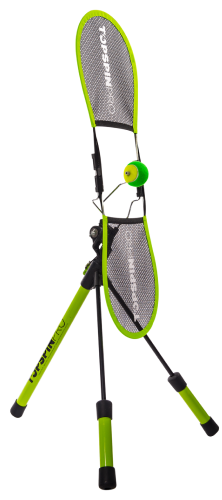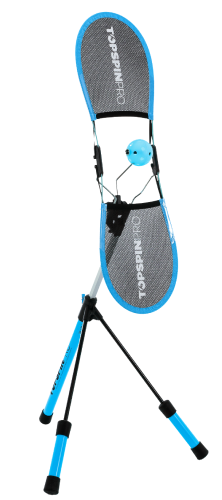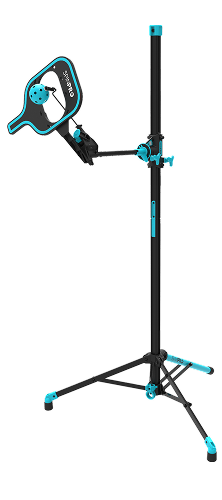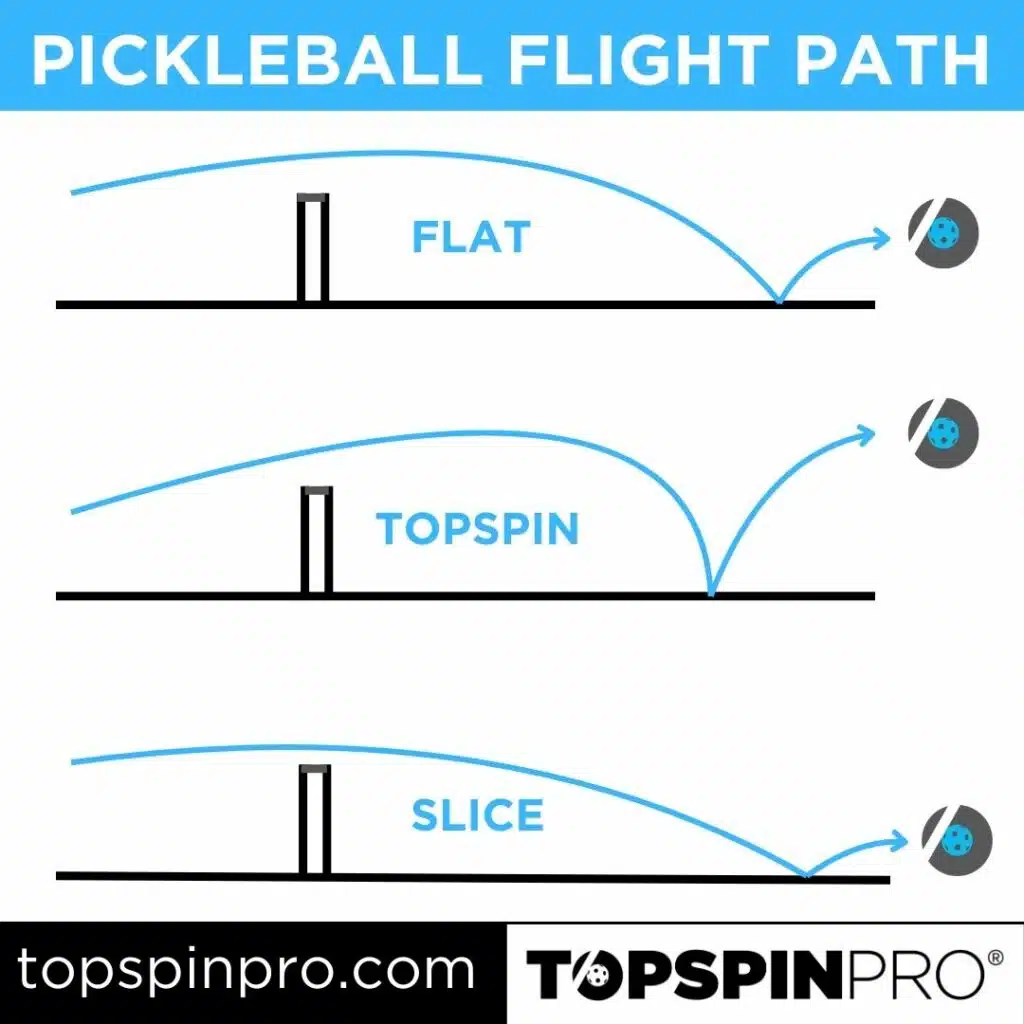
What we'll cover in this article:
Stay in the loop!
Want to be updated when we publish? Be sure to sign up for our newsletter. No spam, we promise!
In pickleball, versatility is the key to becoming an effective player. Two common and contrasting shot techniques are the slice and topspin. Understanding the differences between these two can significantly improve your gameplay and help you strategically outplay your opponents. This article will delve into slice vs. topspin, what the shots are, how they are executed, and when to use each to gain a competitive edge.
Why is Spin Important for Pickleball?
When playing pickleball you can try to control a point in 5 main ways; using direction, power, height, depth and last but most important is spin. Using spin, both topspin and slice, is crucial to competing successfully and moving up to and beyond the 4.0 level. This mastery of spin will enable you to compete more aggressively and with more varied tactics. For many players though, it is often the most difficult skill to develop.
TOPSPIN
What is Topspin?
The name topspin implies that you hit the top of the ball, which in other sports can be true, but not so much in racket sports where we are mostly trying to lift the ball up and over some form of net. Topspin is the forward rotation of the ball and involves striking the ball in an upward motion, thus creating forward spin. This topspin causes the ball to dip sharply, know as the Magnus Effect, and also bounce higher, making it harder for opponents to handle.
How to Create Topspin
Topspin is created by the resulting friction between the paddle and ball. The upward motion of the paddle touching the back of the ball causes it to roll, producing topspin. The faster your paddle travels up the ball, the more friction is generated and the more spin you create. The swing shape we associate with generating topspin is often known as the windshield wiper. In pickleball we can use this across a variety of shots, including serves, dinks, volleys, lobs, and groundstrokes.
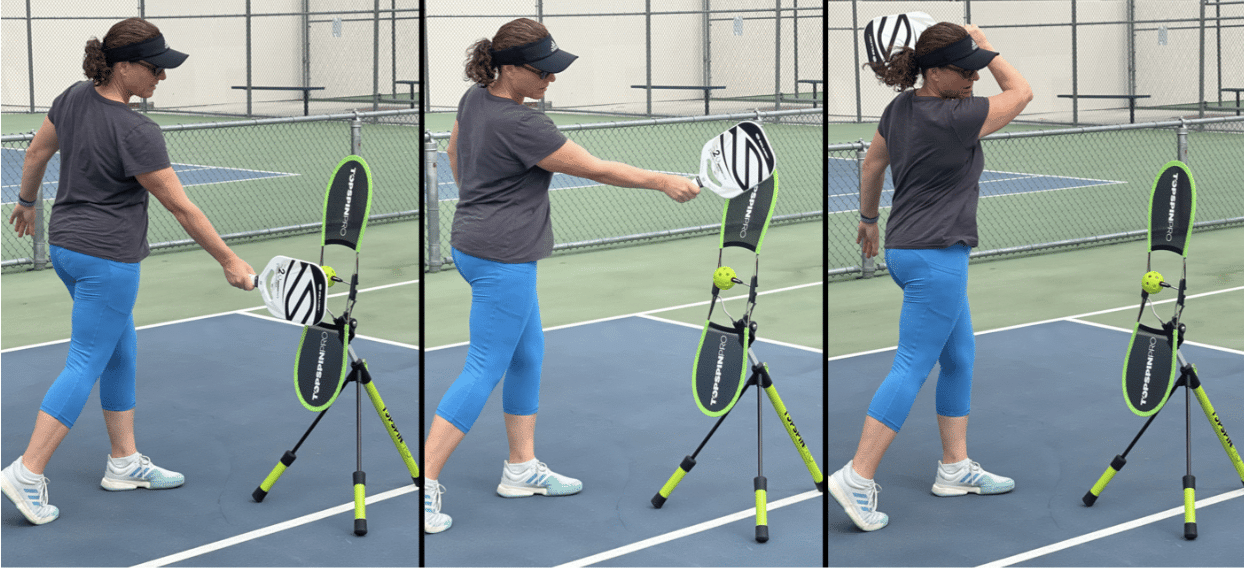
The picture above shows upward motion of the paddle and the windshield wiper shape used to apply maximum topspin to the ball.
Topspin Technique
Grip: Topspin can be applied using continental but is easier with an eastern or semi-western grip.
Swing Path: Swing from low to high, brushing your paddle up the back of the ball.
Follow-Through: Follow through high above the contact point. Either over your shoulder or with your arm lifted.
If you need a little help with finding your grips, here's a quick guide:


The Benefits of Topspin
Consistency - Hitting the ball with a larger net clearance means less errors in the net. This can be useful for return of serve, lob and general groundstrokes, especially in singles when there is no-one close to the net to reach a higher ball.
Accuracy and Aggression - The Magnus Effect causes an arc-shaped flight path which means we can:
- Serve with an aggressive height, depth and speed
- Dip the ball down closer to opponent's feet
- Create wider angles off the side of the court
- Hit more aggressive lobs (higher/faster)
- Lift volleys with topspin and have them still drop in
Injury Prevention - The added bonus of using topspin is that it's bio-mechanically efficient for your body. You are effectively rolling the ball back into the court vs hitting it. That upward topspin action takes away a large amount of the strike impact and therefore protects your body from overuse and shock injuries. Imagine swinging your paddle directly in a straight line at a solid wall vs glancing your paddle straight up it. You know which one will hurt more!
SLICE
What is Slice?
A slice shot in pickleball involves hitting the ball using a downward paddle motion to impart backspin. Slice is the backward rotation of the ball. This backspin causes the ball to travel in a slower and lower trajectory and skid upon bouncing, making it difficult for opponents to return aggressively.
How to Create Slice
Slice is the opposite of topspin and is created by the downward motion of the paddle on the back of the ball and the friction caused by that contact. This causes the ball to rotate backward, resulting in slice. The faster your paddle travels down the ball the more friction is generated and the more spin you create.
Slice Technique
Grip: Continental grip is most effective.
Swing Path: Swing from high to low, making contact with the ball in front of your body.
Follow-Through: Follow through with a downward motion, ending below the point of contact.
Here's a more in depth article covering the benefits of slice.
The Benefits of Slice
More Time - Adding slice to the ball slows it down. When hit with a little loft and depth, it gives you extra time to get up the NVZ line, especially when returning. This makes it an ideal shot for doubles. It can also be helpful to give you extra time when on the defensive in singles!
Lower Bounce - The slice causes the ball to stay low and skid upon bouncing, making it difficult for opponents to execute shots. It is especially useful against taller players or those with limited reach.
Disrupts Rhythm - A well-executed slice can change the game's pace, throwing off your opponent's timing and creating opportunities for unforced errors.
Improves Dinking - During net play, a slice can keep the ball low, making it harder for opponents to attack aggressively. It also keeps them guessing what shot you will choose if you mix it up with topspin.

When to Use Slice and Topspin
When to Use Topspin
Aggressive Baseline Play: To push opponents back and control the pace of the rally, especially in singles.
Drops: Use topspin to dip the ball effectively at your opponent’s feet.
Drives: Topspin enables you to control your pace so will give you an extra dip on your drives.
Lobs: To hit high, deep lobs that push your opponent back.
Dinks: The extra control provided by topspin means you can dink more aggressively
Serves: Topspin enables you to adjust the height of your serve and also increase pace. Use topspin to mix up your serves and keep your opponent guessing
Volleys: Topspin helps you lift up lower volleys using the roll technique plus controls your more aggressive volleys into the court.

When to Use Slice
Defensive Play: When you need time to recover or reset the point.
Approach Shots: To keep the ball low and force a weak return from your opponent during singles and to chip it higher and deeper in doubles giving you time to approach the NVZ.
Dinking: During dink exchanges at the net, to keep the ball low and challenging for your opponent to attack.It’s great to mix in slice with topspin during your dink exchanges.
Change of Pace: To disrupt an opponent who prefers fast rallies.
Serves: Adding slice and especially with a little side slice gives you the option of swinging the ball out wide on your serve.
Drops: Like with topspin, adding slice to your drops can put your opponent under pressure. Lifting a well placed slice drop can often pop the ball up to put you in an attacking position.
How the TopspinPro Can Help Your Game
The Pickleball TopspinPro allows you to practice your topspin and slice using a static ball = no pressure. It's all too common for people to try and implement a new skill in a game situation and then they get frustrated with the negative results. Isolating a skill enables you to practice with the correct technique enough times that you can build up required muscle memory and without getting distracted by the "outcome" (where the ball travels). You can also practice anywhere, anytime, with a fully foldable device and carry bag for transportation. Once you begin to master that skill you can start to add it into situations with a little more pressure such as rallying. Then ultimately into a game situation. You can even remove the panels on the TopspinPro to add in your forward swing and practice blending for different types of shot.


Conclusion
Both slice and topspin shots are essential tools in a pickleball player’s arsenal, each offering unique advantages and strategic benefits. By understanding the differences and knowing when to use each shot, you can enhance your versatility on the court and become a more formidable opponent. Practice both techniques regularly to master their execution and incorporate them into your gameplay for a well-rounded approach to pickleball.
Master Technique With The SpinPro
If you want to add more spin to your game or master certain techniques try the SpinPro. It's a simple and effective way to learn the correct biomechanics without the pressure of an incoming ball!


FAQs
-
Why is spin important for pickleball?
Spin, including topspin and slice, is crucial in pickleball to control the point using direction, power, height, and depth. Mastering spin allows players to compete more aggressively and with varied tactics, which is essential for advancing to higher levels of play.
-
What is topspin and how is it created?
Topspin is the forward rotation of the ball, created by striking it in an upward motion with the paddle. The friction between the paddle and the ball causes it to roll forward, making the ball dip sharply and bounce higher, which can be difficult for opponents to handle.
-
What are the benefits of using topspin in pickleball?
Topspin offers consistency by allowing higher net clearance, reducing errors. It also provides accuracy and aggression, enabling players to serve with height and speed, dip the ball closer to opponents’ feet, and create wider angles. Additionally, topspin is biomechanically efficient, reducing the risk of injury.
-
What is a slice in pickleball and how is it executed?
A slice involves hitting the ball with a downward paddle motion to impart backspin. This backspin slows the ball, causing a lower trajectory and a skidding bounce, making it challenging for opponents to return aggressively.
-
When should you use slice and topspin in pickleball?
Use topspin for aggressive baseline play, drops, drives, lobs, dinks, serves, and volleys to control the rally’s pace. Slice is ideal for defensive play, approach shots, dinking exchanges, changing the pace, and serves to disrupt your opponent’s rhythm and create opportunities for weak returns.
Links Related to This Article
Enjoyed this article?
Be sure to sign up for our newsletter and we'll keep you up to date about new posts
